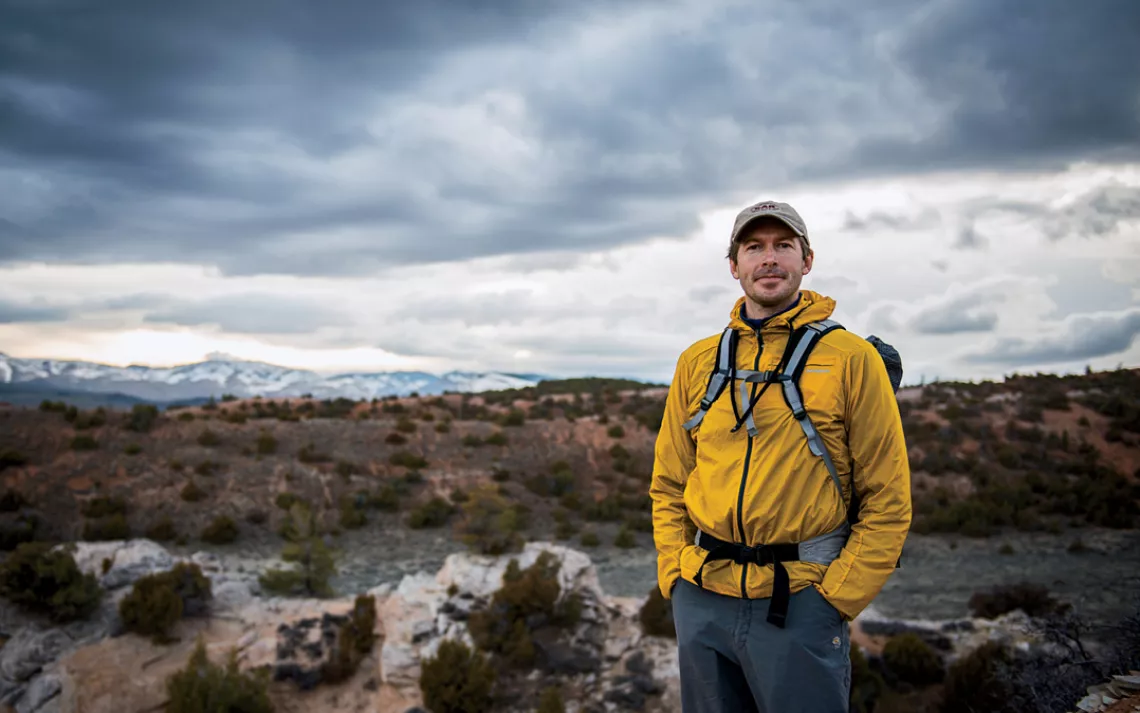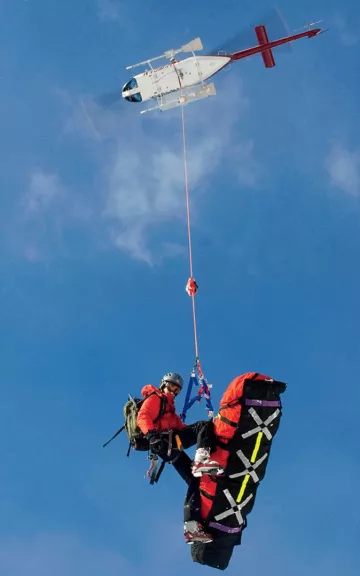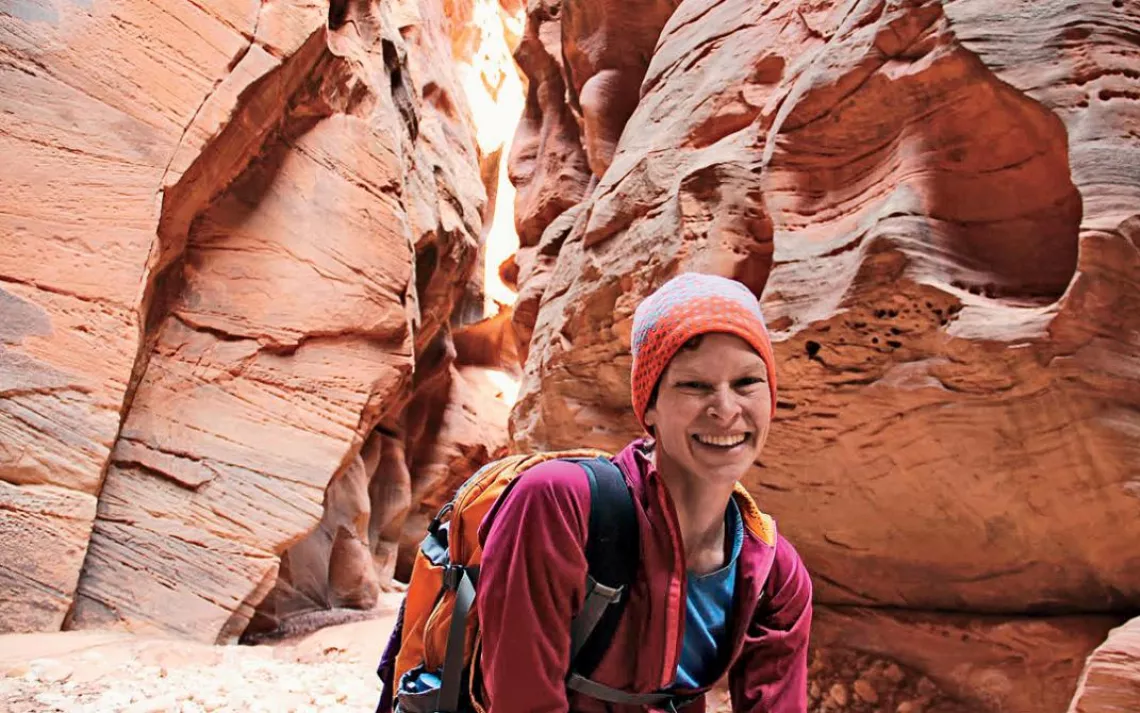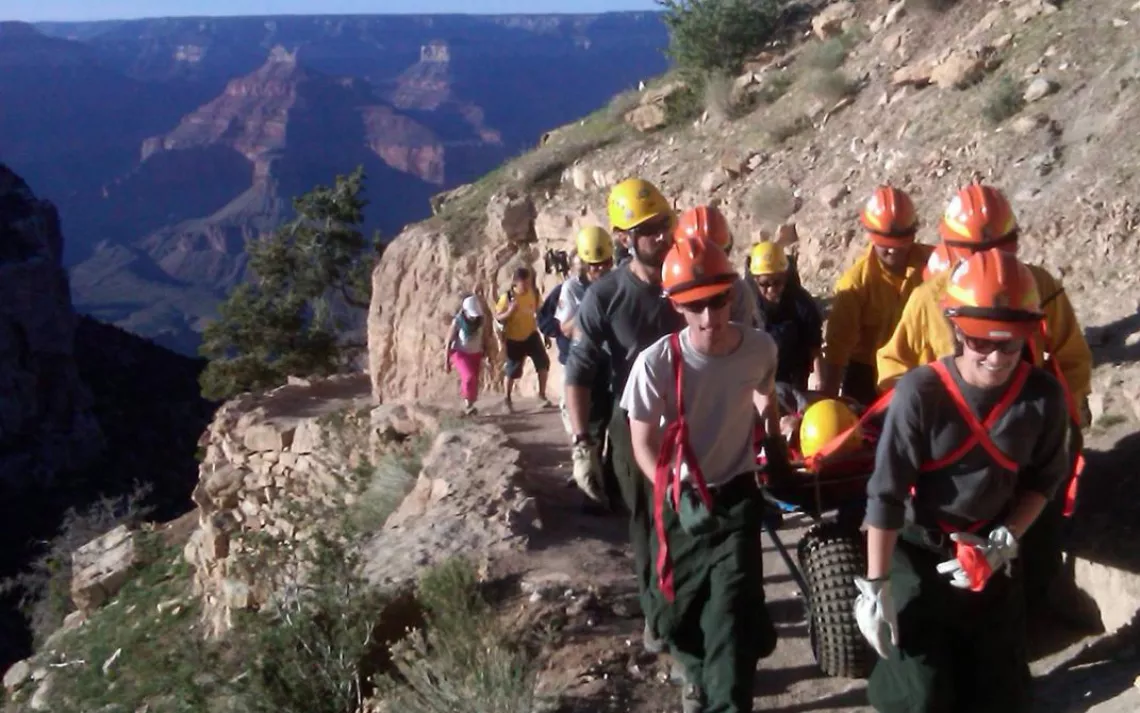The Danger of a Life-Saving Device
A device the size of an energy bar lets backcountry travelers summon assistance from nearly anywhere on Earth. It's saved lives. But the ability to call for help at the push of a button isn't always a good thing.

Fremont County Search & Rescue volunteer Scott Christy at the base of the Wind River Range, Wyoming. | Photo by Steven Brutger
THE SKY ABOVE LANDER, WYOMING, WAS MUDDLED WITH SMOKE from a wildfire chewing on nearly 2,000 acres in nearby Sinks Canyon. Inside the small office of a fisheries-conservation nonprofit in town, Scott Christy, distracted by the blaze, fought to stay focused on his email in-box.
Then the text came: a request for Fremont County Search & Rescue members to make their way to the sheriff's office. An officer with the volunteer unit and a wilderness-skills instructor for 20 years, Christy began to triage his outstanding tasks so he could be where he was needed most.
Christy made the short walk down 1st Street to the sheriff's office, where volunteers were trickling into the command center—a windowless conference room filled with old folding chairs and banquet tables. The emergency dispatcher was on the phone with a woman named Jessica from Colorado. (Jessica's name has been changed to protect her identity.)
Jessica explained that her 38-year-old husband was backpacking through the granite canyons and fish-filled lakes of the Wind River Range just west of Lander, and she had just received a text from him that read: "HELP!!! I AM ALIVE SOMETHING IS TERRIBLY WRONG SEND HELP IMMEDIATELY."
The text had not come from her husband's cellphone—it had come from his SPOT, a satellite emergency notification device (or SEND) that has become popular among backcountry travelers for its ability to summon help from nearly anywhere in the world.
Jessica had no idea what to do. Christy and his colleagues weren't entirely sure either.
What puzzled Christy and his teammates about the current case was that the man could have used his device to send an S.O.S. signal that would have routed directly to emergency dispatchers. Instead, Jessica kept receiving the same disturbing custom text message, which routed directly to her cellphone, leading her to notify the authorities.
A year earlier, Christy had responded to another SPOT call that was an S.O.S. activation. He and a teammate had flown deep into the Wind River Range, where they'd found Leah Cox, whose left thigh had been sliced open from groin to knee by a dislodged boulder. The quick response enabled by the SPOT had probably saved Cox's life. Might this be another Leah? he wondered. If it was, why hadn't the S.O.S. button been activated?
GPS coordinates accompanying the man's messages put him near an unnamed lake at the head of Silas Canyon, on the eastern fringe of the Wind River Range—just a stray ember's reach from the fire, which significantly upped the complexity of any potential search-and-rescue operation in the area.
While the team pulled up coordinates on Google Earth and pored over maps, Christy got on the phone with SPOT representatives to see if their dispatch center had received an S.O.S. signal. It had not. Soon the Shoshone National Forest's recreation supervisor arrived to brief the team on firefighting operations in Sinks Canyon, where helicopters and planes were working through the smoke to protect 50 homes high on the ridgeline and keep flames from spilling onto the forested slopes. Nearly 250 firefighters had converged in the canyon. Tanker planes were dropping slurry on the flames. Residents were evacuating.
As Christy juggled phone calls and rounded up other volunteers, a small search team loaded into a pickup truck for the hour-long drive to the trailhead, up a heavily rutted road. Equipped with overnight gear and medical supplies, the group would hike the remaining four miles to the lake, where they were ready to find a man who needed saving.

A member of the Grand Teton National Park Search & Rescue team aids a backcountry snowboarder with a broken leg. | Photo by Bradly J. Boner
UNTIL THE EARLY 2000s, most search-and-rescue missions were launched in response to signals that arrived slowly, but usually the request was clear. Someone might call 911 when a loved one hadn't come home from a weekend romp; a runner might leave a stranded party in the mountains to retrieve help from civilization; an injured hiker might send a smoke signal from the ground.
Today, search-and-rescues are increasingly initiated in response to calls from SENDs—like the ones carried by Leah Cox and the man in Silas Canyon—or from personal locator beacons (PLBs), another type of emergency signaling device. Working off satellites, the devices have much better coverage than cellphones and are significantly cheaper than satellite phones. This backcountry tech boom has reduced the "search" in search-and-rescue.
But the devices make it very easy for people to call for help, which isn't always a good thing.
As the technology becomes more widespread, so do instances of its misuse, which can put rescuers at risk as well as tax the resources of publicly funded search-and-rescue operations.
Examples of rescue-beacon gaffes now abound, like the infamous 2009 "triple play," when a group of fathers and sons in Grand Canyon National Park activated their SPOT three times in less than 48 hours because their water tasted salty. Another Grand Canyon hiker triggered her device out of concern over her tentmate's loud snoring (she didn't think to wake him up). Then there was the Backpacker magazine editor whose SPOT accidentally went off inside his backpack on a Denali expedition.
When used correctly, the devices can be life-and-limb-saving tools, says Matt Scharper, the search-and-rescue coordinator for California. But he's seen them used for nonemergencies with increasing regularity—like calling out the cavalry for a lone "wolf" (it was a coyote), reporting a mountain lion (it was minding its own business), and pressing a device's emergency button 18 times because a tree stump on the Pacific Crest Trail was smoldering after being struck by lightning.
"Welcome to the mountains," says Scharper. "In the backcountry, that's not an emergency."
In 2012, concerned by decreasing budgets and an increasing number of calls for help, California, which fields the most search-and-rescue calls of any state, started tracking missions initiated by PLBs and SENDs. From 2013 to 2014, they increased from 53 to 87, and 36 of those 2014 calls were either accidental or nonemergency. Even more alarming are stats from the Air Force Rescue Coordination Center, the first recipient of distress calls from PLBs. Although the air force center averages one life saved every 36 hours, 80 percent of its calls are false alarms.
However, it is not just U.S. residents who are guilty of crying wolf. Australia had the world's highest per capita use of rescue beacons as of 2012. That year, only 109 out of 1,700 activations were genuine emergencies.
Scharper speculates that these beacons allow people to take search-and-rescue for granted, casting it as a service on a par with fire and police departments, ambulances, and garbage removal. "We don't want it to affect our response. But the stats speak for themselves," he says. "We keep getting these activations that are ridiculous."

Leah Cox, nine months after a SPOT activation saved her life. | Photo by Bob Bursey/Courtesy of Leah Cox
DeLorme—which produces a popular SEND called the inReach Explorer, with two-way texting—and SPOT both attempt to educate customers about how to use their devices responsibly. DeLorme regularly sends representatives to outdoor-oriented events and works with many gear shops and search-and-rescue teams, says Kim Stiver, the company's vice president of marketing. And SPOT stresses at multiple points throughout the product purchasing and registration process that the S.O.S. button is for emergencies only, says a marketing representative from SPOT's parent company, Globalstar.
"While certainly we can't prevent someone from doing something stupid, we as a company emphasize preparedness," says Stiver. To date, over 70,000 units have been sold. During the peak of last summer, there were an average of five inReach-generated search-and-rescue missions per week. And the company expects the inReach's use to grow "exponentially" in the coming years.
"The more people become aware of the technology and how to use it," says Stiver, "the less likely they will take it out and think, 'Oh, it will save me from whatever I do.'"
But is a simple hope for increased awareness enough, or do companies need to take a more active approach? It stands to reason that if the product's sales grow at the expected rate, false alarms will skyrocket.
"SPOT has a really good public awareness webpage, but I don't think they push that enough," says Scharper. "If they did, we wouldn't see the number of nonemergency calls that we do."
Scharper is concerned that slogans such as "Live to tell about it" (SPOT) and "Get help anywhere in the world" (DeLorme) perpetuate the notion that guaranteed help is just one button push away. What many might not consider is that beacon manufacturers are profiting off of search-and-rescues that come at the expense of public money and often volunteer labor. The National Park Service alone spends $4 million to $5 million on search-and-rescues annually.
Search-and-rescue professionals and recreationalists have debated whether or not people should be fined for false alarm calls, or even charged for rescues outright. Many worry that if people fear being fined or charged for a rescue, they'll wait until the last minute to call for help—when the situation may be more dangerous for everyone. Others are concerned that charging for rescue services will create the perceived guarantee of a rescue, something that can never be promised, given the vagaries of weather, terrain challenges, and resource availability.
In 2007, Oregon state representatives tried unsuccessfully to pass what the local search-and-rescue community called the "Don't Be Stupid" bill—a requirement to carry an electronic signaling device when climbing above 10,000 feet in the state from November to March. The bill failed in the Senate because of opposition from search-and-rescue teams, who feared it would embolden inexperienced, unqualified climbers.

Rescuers at Grand Canyon National Park conduct a litter carryout of an injured patient on the Bright Angel Trail. | Photo courtesy of the National Park Service
SOON AFTER THEY DECIDED TO DEPLOY a Life Flight helicopter to Silas Canyon, the team in the command center received a message that the man's "I'm OK" button had been activated. They tried to alert the helicopter but couldn't—the canyon walls were blocking radio and satellite phone communication. When the air team touched down beside the lake, they found a man apologizing profusely beside his campfire. "I was just messing with the SPOT device to send my wife a good message," he said. He admitted to rescuers that he'd been drinking.
Christy was familiar with calls like this—they reminded him of 911 hang-ups—but what stuck with him about the Silas Canyon rescue was the additional risk the crew had taken for what they thought was a true emergency. As the helicopter pilot walked back into the office, Christy remembers, he mentioned that it was some of the more "interesting" flying he'd done—an understated way of acknowledging the challenge of flying into a canyon at night, with a fire blazing nearby.
No rescuers were injured in the Silas Canyon mission, but the risk to search-and-rescuers is always a serious consideration. In 2009, a helicopter crashed in New Mexico while transporting an uninjured hiker lost four miles from the trailhead, killing the hiker and the pilot. In 2012, another helicopter crash took the life of a volunteer search-and-rescue member responding to an injured snowmobiler in Wyoming. Thirty-two rescuers have died on rescue missions in the National Park Service's history.
"We put rescuers at risk. That was due to the challenges of a SPOT, that gray area when it's not the S.O.S button that gets triggered," says Christy.
While beacon owners may not realize it, once an agency has been contacted for assistance, regardless of whether it's a nonemergency Help or an S.O.S. message, there is often a legal obligation to attempt to respond, and a rescue is still a rescue, regardless of what button was pushed.
Members of the Rocky Mountain National Park Search and Rescue team prepare to transport an injured hiker. | Photo courtesy of the National Park Service
THE ABILITY TO CONNECT from the world's remote areas will continue expanding, and with it, the ability to call for help. Experts predict that within just a few years, two-way emergency satellite communication technology will be integrated into cellphones. Recently, two Australian national parks began providing PLBs free of charge to bush walkers. Some support a similar policy in U.S. parks.
This means that opportunities for backcountry travelers to prematurely call for help will only expand. To the untrained ear, a coyote's howl does sound like a wolf's. Is it proactive or preposterous for a concerned hiker to call in a smoldering stump that could be the start of a wildfire, especially in a tinderbox like California? It takes experience-based knowledge to make informed decisions. For the average adventurer, many of whom now consider an emergency signaling device to be as essential as a sleeping bag or a pair of boots, the answer isn't always obvious.
Rescue Beacons 101
PERSONAL LOCATOR BEACONS (PLBS)
If getting rescued is your only reason for buying a satellite-transmission device, the PLB is a good bet. When activated, it transmits your unique ID code (along with GPS coordinates if your unit has GPS capabilities) to the Air Force Rescue Coordination Center, via the same network of satellites that oceanic vessels have relied on for over 30 years. The AFRCC makes a quick, initial investigation and then dispatches the call to the closest rescue center, often the local sheriff’s department. The PLB’s 406-megahertz signal is stronger than the SEND’s 1610 MHz one, which means that overhead obstructions like cloud cover are less likely to block the transmission. Many PLBs come with a 121.5 MHz homing signal, which rescuers can use as a backup to the GPS coordinates.
Unlike SENDs, PLBs don’t require you to buy a subscription, but you must register your device. Over 50 percent of PLBs are unregistered, making it impossible for authorities to contact the user in cases of accidental activation. These beacons lack the messaging options of a SPOT and the two-way messaging of a DeLorme inReach Explorer, but they’re a cheaper option if you can’t afford two-way communication.
SATELLITE EMERGENCY NOTIFICATION DEVICES (SENDS)
Transmitting on a weaker frequency than PLBs, SENDs rely on newer networks of private satellites and dispatch centers. But popular SENDs like the SPOT Gen3 and the DeLorme inReach Explorer differ from PLBs in their array of functions. The Gen3 has five signaling options, but it only allows for one-way communication: There is no way for the recipient of a message to ask for more details. The Explorer, however, can send and receive text messages via satellite. It’s more expensive than the Gen3, but many guides and rescue professionals believe that two-way communication is the gold standard for this technology. Both SENDs require you to buy a subscription.
CELLPHONES
When you have coverage, cellphones are a useful emergency signaling device. Across the country, dispatch centers are slowly upgrading to “Next Generation 911” technology, which allows them to receive text messages via 911. You can often send and receive texts when reception isn’t good enough for calls. Still, when it comes to dialing 911, not all cellphones are created equal. The CDMA network used by Verizon, Sprint, and Cricket sends GPS coordinates to the 911 center, while the TDMA network used by AT&T and T-Mobile does not. Instead, a TDMA phone estimates your coordinates based on your distance from nearby cellphone towers. The more towers the phone can contact, the more accurate that location will be. —Molly Loomis
 The Magazine of The Sierra Club
The Magazine of The Sierra Club



